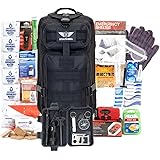The Best Tools to Survive a Wildfire
Table of Contents
- Essential Wildfire Survival Gear
- Creating a Solid Wildfire Escape Plan
- Staying Safe During a Wildfire
- Important Aftermath Steps
Essential Wildfire Survival Gear
Choosing the Right Clothing
When it comes to battling the elements during a wildfire, your clothing can be a game changer. I’ve learned the hard way that cotton isn’t the best choice—it absorbs water and can leave you cold and wet. Opt for moisture-wicking materials that keep you dry. The last thing you want is to be shivering while trying to escape.
Layering is also key, folks! You should have a solid base layer, something thermal to trap your body heat. Add an insulated jacket on top that’s windproof, and finally, a durable outer layer that can resist embers. Trust me, you need these layers, especially on those unpredictable wildfire days.
Don’t forget about your footwear! A good pair of sturdy boots can save your feet from debris and heat. Look for ones with reinforced toes and good grip—you never know when you might need to scramble away from danger.
Must-Have Tools for Safety
Having the right tools during a wildfire is crucial. I always recommend carrying a fire extinguisher that’s rated for wildfires. You might be thinking, “Can’t I just use water?” But trust me, having a fire extinguisher specifically designed for this type of blaze is super important. It could be the difference between a small fire and a catastrophic one.
A shovel and saw are also great. You’ll want to clear up any combustibles around your house or create a firebreak if the situation allows. I’ve had moments where just a little digging made a significant impact. Also, a sturdy pair of gloves is essential—no one wants to deal with burns when they’re already in a tough situation.
Lastly, a portable radio can keep you informed about updates on evacuation routes, fires’ directions, and local news. These little things aren’t as glamorous but are absolutely essential for survival!
Essential Emergency Supplies
You definitely want to have some emergency supplies on hand. I found this out the hard way when I was caught off-guard. A good supply of water—about a gallon per person per day for at least three days—is a must. And let’s not forget about non-perishable food items. Think things like energy bars, canned goods, and whatever you can stuff in a backpack.
== > What if ... Get a FREE Subscription to PREPARE
First aid kits can also be lifesavers—they’re often overlooked. Look for a comprehensive kit that includes bandages, antiseptic wipes, and items for treating smoke inhalation. You might not think you’ll need it, but when those flames get close, all bets are off!
Lastly, make sure you have a reliable flashlight and extra batteries. You never know when the power might go out, and it’s much easier to navigate if you can see where you’re going. Plus, who doesn’t love a good flashlight that can double up as a signaling device if needed?
Creating a Solid Wildfire Escape Plan
Mapping Your Escape Route
Let’s get real: you want to have an escape route mapped out before the smoke starts filling the air. As a person who’s faced wildfires, I can’t stress this enough. Study your surroundings and make at least two escape routes from your home. This just might prove to be invaluable when chaos hits.
I usually recommend picking routes that avoid high-risk areas, like dense woods or those drawn to fire like tall grass. You want to be on the safe side, right? Every now and then, I drive those routes to familiarize myself—your brain can forget in stressful situations.
Also, have a rendezvous point in mind in case you get separated from your family. It can be a neighbor’s house, a nearby park, or wherever feels best for you all. Just remember to communicate your plans clearly!
Practicing Your Escape
Once you’ve figured out your route and rendezvous points, practice makes perfect, folks. I can’t tell you how many times I’ve done fire drills around my neighborhood; it helps everyone be on the same page. It’s all about muscle memory, so when that adrenaline kicks in, you know exactly what to do.
Walk through your escape routes with your family or friends. Use timers to simulate the feeling of urgency—you don’t want to dawdle when chaos strikes. The first couple of times might feel silly, but you’ll be grateful later. It’s a team effort.
Also, don’t forget about your pets! Make sure you include them in your drill, as well. Trust me, you don’t want to be trying to catch a fidgety cat in the chaos. Have carriers ready to go!
Staying Updated on Conditions
Stay informed about fire conditions in your area. There are plenty of apps and websites that provide real-time updates on weather and fire alerts. It’s almost like a game-changer for wildfire preparedness. I’ve found that knowing how close a fire is can help me make quick decisions about whether to evacuate now or later.
Consider setting up alerts on your phone. Getting a ping when a wildfire is advised to your area can give you that much-needed head start. Always be the one ahead of the curve; you really don’t want to be caught off-guard by rising flames.
Lastly, pay attention to evacuation orders from local officials. They have your safety at heart, so when they say go, you go. No questions asked!
Staying Safe During a Wildfire
Finding Shelter
When a wildfire is threatening, finding proper shelter is paramount. If you have time, head for a sturdy building instead of your car. I realized during one encounter that parking in a garage or near a stone or brick structure, rather than a wooden one, can save lives. It seems basic, but it can make a world of difference.
Also, the more windows and doors a building has, the more potential risks there are. Go for buildings that have fewer openings, which are safer during a wildfire, as they’re less likely to ignite due to embers.
If you really can’t get to a solid building, find a safe area away from heavy vegetation. If you’ve got a dirt or gravel area, that’s even better as the fire is less likely to spread there!
Protecting Yourself from Smoke
Smoke inhalation can be just as dangerous as flames, so protecting yourself is essential. A simple piece of cloth can help; create a mask to cover your nose and mouth. However, I found that those N95 masks are a real lifesaver. They filter out harmful particles in the air and can be a quick way to give yourself a fighting chance.
Don’t underestimate the power of hydration either. Keeping water with you can help keep your throat and airways moistened, easing that dry tickle you might feel while inhaling smoky air. Coming in prepared makes all the difference.
Lastly, keep an eye on where the wind is blowing the smoke. Often, if you can keep an eye on the wind direction and the fire’s movement, you can better assess your safety and whether you should keep moving or stay put. Knowledge is power!
Staying Calm Amid Chaos
Look, I get it—stress levels go through the roof in a wildfire situation. The key here is staying calm. Take a few deep breaths and assess the situation. When I’ve panicked, I’ve made terrible decisions that could’ve easily been avoided if I’d just paused for a moment.
Focus on the basics: your survival and that of your loved ones. Stay focused on your escape plan, along with keeping communication open with others around you. Having a clear head helps guide your next actions.
Remember, we are generally more resilient than we think. Remind yourself that you’ve prepared for this. Lean on your plan, your gear, and your instincts, and stay focused on each step you need to take.
Important Aftermath Steps
Assessing Your Property
Once it’s safe to return home, the first thing I do is assess the damage. I start by checking for any remaining hot spots and potential fires lurking beneath debris. Make sure to thoroughly inspect everything—roofs, decks, and even under porches. It’s all too easy for a small ember to reignite.
Next, don’t dive into action without proper gear. You should have gloves, a mask, and sturdy boots. Safety first, people! After all that smoke exposure, your lungs need a break, too.
Document everything. Take photos and gather evidence for insurance claims. It’s not legal jargon; it’s a practical step you don’t want to skip, trust me. It makes the whole claims process much smoother.
Cleaning Up Safely
The cleanup post-wildfire isn’t just about shoveling ash and debris. Use caution when nearing burnt trees or shrubs, as they might easily topple over. Also, check for nails and sharp objects hidden beneath the debris—it’s all about keeping those toes safe!
Consider hiring professionals for the cleanup if you’re overwhelmed. After a wildfire, there can be toxic materials lingering around, so having experts handle it can be a lifesaver for your health and safety.
Don’t rush the process, either! It’s easy to feel the pressure to get everything done quickly, but proper cleanup takes time. Getting ahead of yourself can lead to injuries. Go slow and thorough; your well-being is what’s most important.
Rebuilding and Moving Forward
Once everything is cleaned up and you’ve assessed your home, it’s time to think about rebuilding. Consider using fire-resistant materials if you plan on reconstructing. I found that this could save you from future headaches down the line.
Stay optimistic, but be realistic about your situation, too. It’s a tough time no doubt, but persistence is key. Lean on your loved ones; share your experience and emotions with them. Rebuilding isn’t just a physical endeavor—it’s about emotional healing too.
Reflecting on your experience can be incredibly cathartic, so don’t shy away from feelings while you’re picking up the pieces. Just know you’re not alone in this—many have come through it, and you will, too!
FAQs
What should I pack for a wildfire emergency kit?
Packing essentials like water, non-perishable food, a flashlight, first-aid kit, fire extinguisher, and protective clothing is vital for wildfire preparedness. Always customize your kit according to your family’s specific needs.
How can I stay informed about local fire alerts?
Setting up alerts on your phone for local wildfire news from weather apps or official county services is a must! Social media and local radio stations are also great for getting real-time updates.
What should I do if I’m caught in a wildfire?
If you find yourself in a wildfire, look for the safest escape route, seek shelter in a sturdy building, and cover your mouth and nose from smoke. Stay as calm as you can, and follow your escape plan.
How can I prepare my home to be fire-resistant?
Use fire-resistant materials for any new building or repairs, clear flammable debris from your property, and create defensible space around your home. Regularly maintain your yard to mitigate fire risk.
Related Content
4Patriots 72-Hour Survival Food Kit: Emergency Food Supply Designed to Last 25 Years, 20 Servings
$23.20 (as of November 29, 2025 13:25 GMT -05:00 - More infoProduct prices and availability are accurate as of the date/time indicated and are subject to change. Any price and availability information displayed on [relevant Amazon Site(s), as applicable] at the time of purchase will apply to the purchase of this product.)Stealth Angel Survival - 72 Hour Family Emergency Kit - 1-5 Person Survival Bag for Earthquakes, Hurricanes, and Other Natural Disasters
Now retrieving the price.
(as of November 29, 2025 13:25 GMT -05:00 - More infoProduct prices and availability are accurate as of the date/time indicated and are subject to change. Any price and availability information displayed on [relevant Amazon Site(s), as applicable] at the time of purchase will apply to the purchase of this product.)





